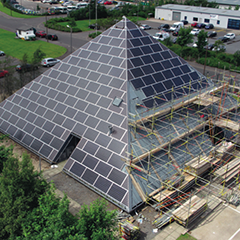We take a look at this ambitious Scottish design, which posed an immense challenge for its project planners due to its steep inclination of almost 45 degrees…
Tom King has come full circle. The managing director of Sustainable Renewable Technologies (SRT) began his career as a land surveyor in the coal mining industry in exactly the same location as where he is now implementing his current model project. SRT has fitted solar panels to the entire exterior of Survey Solutions Scotland’s striking pyramid-shaped office, which is located in the Scottish town of Loanhead, just south of Edinburgh. Completing the project took the planners down a long and winding road with many challenges being met along the way.
It was King himself who presented the idea for the project to Survey Solutions Scotland. Having already expressed an interest to other project planners in installing a solar system onto their building and having been rejected each time, it was easy to convince them of the idea. In addition to using the project to reduce their energy costs and to prove that they are playing a part in combating climate change, the company wished to improve the external appearance of their headquarters.
Being land surveyors, Survey Solutions Scotland wanted the solar system to fit seamlessly with the building’s straight lines. This meant avoiding the traditional stepped-edge finish that appears when rectangular solar modules are used. In conjunction with the building’s unusual inclination, this provided another reason for many companies declaring the project ‘impossible’. Despite these obstacles, however, Tom King took control of the design layout and financing of the project in 2012.
Mock solar panels create the perfect triangle
To ensure that each side of the pyramid consisted of a perfect triangle of solar panels, the SRT project planners sought advice from a graphic design company. The graphic designers came up with the idea of using mock solar panels on the edges of the triangles that look remarkably like the installed modules themselves. The mock panels were cut in such a way to ensure they were level with the PV modules and the pyramid’s edges. The installation, which has a capacity of 48.25 kWp, comprises 193 Jetion JT250 SBb modules and four Danfoss TLX 12.5 inverters.



























